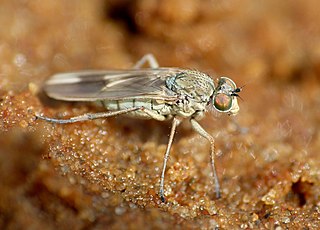Harold Oldroyd (24 December 1913 – 3 September 1978) was a British entomologist. He specialised in the biology of flies, and wrote many books, especially popular science that helped entomology to reach a broader public. His The Natural History of Flies is considered to be the "fly Bible". Although his speciality was the Diptera, he acknowledged that they are not a popular topic: "Breeding in dung, carrion, sewage and even living flesh, flies are a subject of disgust...not to be discussed in polite society". It was Oldroyd who proposed the idea of hyphenating the names of true flies (Diptera) to distinguish them from other insects with "fly" in their names. Thus, the "house-fly", "crane-fly" and "blow-fly" would be true flies, while the "dragonfly", "scorpion fly" and so on belong to other orders. He also debunked the calculation that a single pair of house-flies, if allowed to reproduce without inhibitions could, within nine months, number 5.6×1012 individuals, enough to cover the Earth to a thickness of 14.3 m (47 ft). Oldroyd calculated that such a layer would only cover Germany, but remarked "that is still a lot of flies".
Acropsilus is a genus of flies in the family Dolichopodidae. It is unplaced in the family, having been placed variously in subfamilies such as Sympycninae or Peloropeodinae. It is superficially similar to the Medeterinae.
Antyx is a genus of flies in the family Dolichopodidae from the Australasian realm. The genus was originally placed in the subfamily Sympycninae, but it was later found to be closer to the Neurigoninae and was placed as incertae sedis within the family. In the World Catalog of Dolichopodidae by Yang et al. (2006), the new subfamily Antyxinae was proposed, in which Antyx is the only genus. However, the validity of this new subfamily was later criticized by Sinclair et al. (2008). According to them, the subfamily's erection by Yang et al. (2006) was not justified by their phylogenetic analysis, and the genus would have been better placed as incertae sedis until a later phylogenetic study determines its placement.
Babindella is a genus of flies in the family Dolichopodidae from Australia. It is the only genus in the subfamily Babindellinae, and is named after Babinda, the type locality. According to Grichanov (2018), there may be no basis for a separate subfamily for Babindella, which is considered to be related to several genera of Medeterinae such as Udzungwomyia.
Ceratopos is a genus of flies in the family Dolichopodidae, known from Algeria and Portugal. It contains only one species, Ceratopos seguyi. It is closely related to Syntormon, and is considered a junior synonym of it according to Evenhuis & Bickel (2022).
Colobocerus is a genus of flies in the family Dolichopodidae, known from New Zealand. It contains only one species, Colobocerus alchymicus. According to Bickel (1992), Colobocerus should probably be treated as a synonym of Sympycnus.
Corindia is a genus of flies in the family Dolichopodidae. It is known mainly from the Afrotropical and Australasian realms, with a single species from the Palaearctic realm and an undescribed species also known from the Neotropical realm. The genus was first described in 1986 by Daniel J. Bickel, who originally considered it to be the sister group of the genus Thrypticus. Bickel later suggested that Corindia may represent a plesiomorphic and paraphlyetic assemblage from which Thrypticus arose.

Medetera is a large genus of flies in the family Dolichopodidae. It includes about 350 species worldwide. The adults are commonly found resting on vertical surfaces such as tree trunks, on which they have a characteristic vertical upright stance. Because of this stance, they are sometimes known as "woodpecker flies". Medetera adults are predators of soft-bodied arthropods, while the larvae are predators of bark beetle larvae.
Naufraga hexachaeta is a species of fly in the family Dolichopodidae. It is the only member of the genus Naufraga, and is found in New Zealand.

Parentia is a large genus of flies in the family Dolichopodidae.

Scorpiurus is a genus of flies in the family Dolichopodidae, endemic to New Zealand. Members of the genus are found in marine littoral habitats.

Hydrophorinae is a subfamily of flies in the family Dolichopodidae. Several molecular phylogenetic analyses of the family have found evidence that the subfamily in its current sense is polyphyletic.

Achalcinae is a subfamily of flies in the family Dolichopodidae. It is an ancestral group close to Medeterinae and Sciapodinae.

Sciapodinae is a subfamily of flies in the family Dolichopodidae. Members of the subfamily possess several ancestral characteristics of the family, such as branched vein M1+2 in the wings (though M2 is absent or reduced in Mesorhagini) and a pedunculate hypopygium. They also typically have a deeply excavated vertex, giving their heads the appearance of a dumbbell when viewed from the front.

Diaphorinae is a subfamily of flies in the family Dolichopodidae.

Medeterinae is a subfamily of flies in the family Dolichopodidae.

Peloropeodinae is a subfamily of flies in the family Dolichopodidae. In some classifications, the genera of the subfamily are included in Sympycninae. According to a molecular phylogenetic analysis of the family Dolichopodidae by Germann et al. (2011), the subfamily is polyphyletic.

Sympycninae is a subfamily of flies in the family Dolichopodidae. In some classifications, this subfamily includes the genera of the subfamilies Peloropeodinae and Xanthochlorinae.

Sciapodini is a tribe of flies in the family Dolichopodidae.











